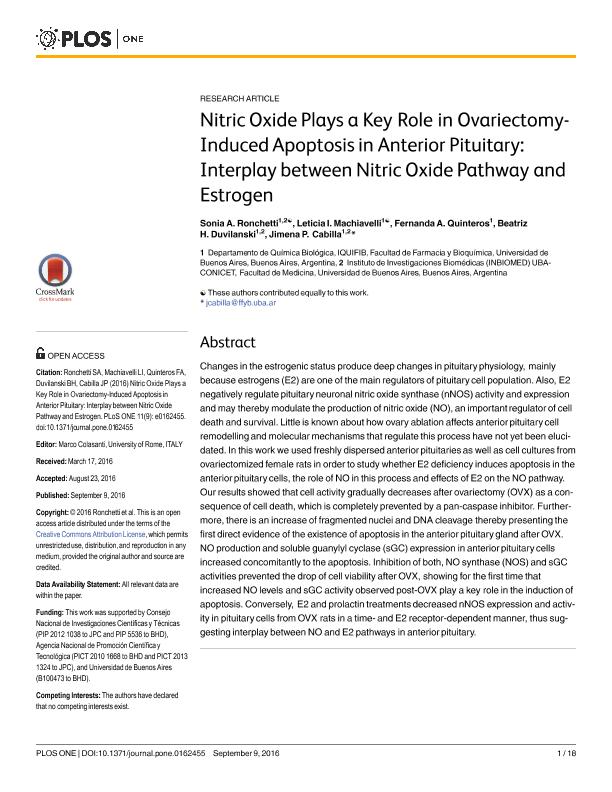Mostrar el registro sencillo del ítem
dc.contributor.author
Ronchetti, Sonia Alejandra

dc.contributor.author
Machiavelli, Leticia Ines

dc.contributor.author
Quinteros, Alnilan Fernanda

dc.contributor.author
Duvilanski, Beatriz Haydee

dc.contributor.author
Cabilla, Jimena Paula

dc.date.available
2018-06-18T21:12:01Z
dc.date.issued
2016-09
dc.identifier.citation
Ronchetti, Sonia Alejandra; Machiavelli, Leticia Ines; Quinteros, Alnilan Fernanda; Duvilanski, Beatriz Haydee; Cabilla, Jimena Paula; Nitric oxide plays a key role in ovariectomy-induced apoptosis in anterior pituitary: Interplay between nitric oxide pathway and estrogen; Public Library of Science; Plos One; 11; 9; 9-2016; 1-18; e0162455
dc.identifier.uri
http://hdl.handle.net/11336/49174
dc.description.abstract
Changes in the estrogenic status produce deep changes in pituitary physiology, mainly because estrogens (E2) are one of the main regulators of pituitary cell population. Also, E2 negatively regulate pituitary neuronal nitric oxide synthase (nNOS) activity and expression and may thereby modulate the production of nitric oxide (NO), an important regulator of cell death and survival. Little is known about how ovary ablation affects anterior pituitary cell remodelling and molecular mechanisms that regulate this process have not yet been elucidated. In this work we used freshly dispersed anterior pituitaries as well as cell cultures from ovariectomized female rats in order to study whether E2 deficiency induces apoptosis in the anterior pituitary cells, the role of NO in this process and effects of E2 on the NO pathway. Our results showed that cell activity gradually decreases after ovariectomy (OVX) as a consequence of cell death, which is completely prevented by a pan-caspase inhibitor. Furthermore, there is an increase of fragmented nuclei and DNA cleavage thereby presenting the first direct evidence of the existence of apoptosis in the anterior pituitary gland afterOVX. NO production and soluble guanylyl cyclase (sGC) expression in anterior pituitary cells increased concomitantly to the apoptosis. Inhibition of both, NO synthase (NOS) and sGC activities prevented the drop of cell viability afterOVX, showing for the first time that increased NO levels and sGC activity observed post-OVX play a key role in the induction of apoptosis. Conversely, E2 and prolactin treatments decreased nNOS expression and activity in pituitary cells fromOVX rats in a time- and E2 receptor-dependent manner, thus suggesting interplay between NO and E2 pathways in anterior pituitary.
dc.format
application/pdf
dc.language.iso
eng
dc.publisher
Public Library of Science

dc.rights
info:eu-repo/semantics/openAccess
dc.rights.uri
https://creativecommons.org/licenses/by-nc-sa/2.5/ar/
dc.subject
Nitric Oxide
dc.subject
Ovariectomy
dc.subject
Apoptosis
dc.subject
Estrogen
dc.subject.classification
Otras Medicina Básica

dc.subject.classification
Medicina Básica

dc.subject.classification
CIENCIAS MÉDICAS Y DE LA SALUD

dc.title
Nitric oxide plays a key role in ovariectomy-induced apoptosis in anterior pituitary: Interplay between nitric oxide pathway and estrogen
dc.type
info:eu-repo/semantics/article
dc.type
info:ar-repo/semantics/artículo
dc.type
info:eu-repo/semantics/publishedVersion
dc.date.updated
2018-06-06T13:38:46Z
dc.identifier.eissn
1932-6203
dc.journal.volume
11
dc.journal.number
9
dc.journal.pagination
1-18; e0162455
dc.journal.pais
Estados Unidos

dc.journal.ciudad
San Francisco
dc.description.fil
Fil: Ronchetti, Sonia Alejandra. Consejo Nacional de Investigaciones Científicas y Técnicas. Oficina de Coordinación Administrativa Houssay. Instituto de Investigaciones Biomédicas. Universidad de Buenos Aires. Facultad de Medicina. Instituto de Investigaciones Biomédicas; Argentina
dc.description.fil
Fil: Machiavelli, Leticia Ines. Consejo Nacional de Investigaciones Científicas y Técnicas. Oficina de Coordinación Administrativa Houssay. Instituto de Investigaciones Biomédicas. Universidad de Buenos Aires. Facultad de Medicina. Instituto de Investigaciones Biomédicas; Argentina
dc.description.fil
Fil: Quinteros, Fernanda A.. Consejo Nacional de Investigaciones Científicas y Técnicas. Oficina de Coordinación Administrativa Houssay. Instituto de Investigaciones Biomédicas. Universidad de Buenos Aires. Facultad de Medicina. Instituto de Investigaciones Biomédicas; Argentina
dc.description.fil
Fil: Duvilanski, Beatriz Haydee. Consejo Nacional de Investigaciones Científicas y Técnicas. Oficina de Coordinación Administrativa Houssay. Instituto de Investigaciones Biomédicas. Universidad de Buenos Aires. Facultad de Medicina. Instituto de Investigaciones Biomédicas; Argentina
dc.description.fil
Fil: Cabilla, Jimena Paula. Consejo Nacional de Investigaciones Científicas y Técnicas. Oficina de Coordinación Administrativa Houssay. Instituto de Investigaciones Biomédicas. Universidad de Buenos Aires. Facultad de Medicina. Instituto de Investigaciones Biomédicas; Argentina
dc.journal.title
Plos One

dc.relation.alternativeid
info:eu-repo/semantics/altIdentifier/doi/http://dx.doi.org/10.1371/journal.pone.0162455
dc.relation.alternativeid
info:eu-repo/semantics/altIdentifier/url/http://journals.plos.org/plosone/article?id=10.1371/journal.pone.0162455
Archivos asociados
